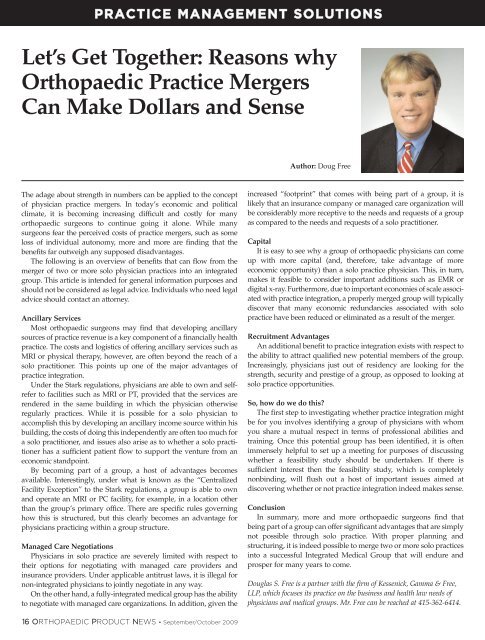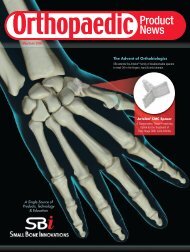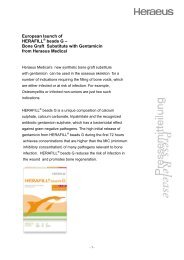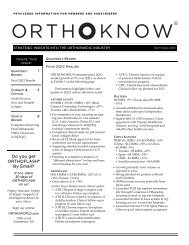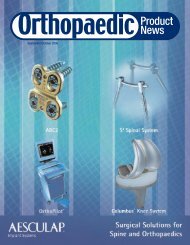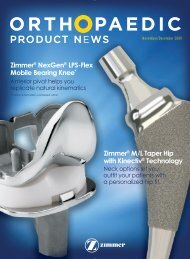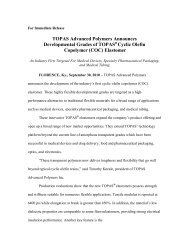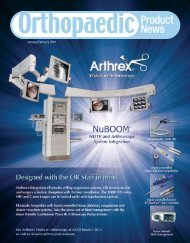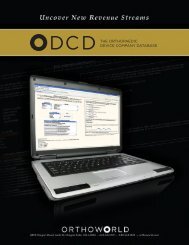Spinal Surgery, Cement Systems - Orthoworld
Spinal Surgery, Cement Systems - Orthoworld
Spinal Surgery, Cement Systems - Orthoworld
Create successful ePaper yourself
Turn your PDF publications into a flip-book with our unique Google optimized e-Paper software.
PRACTICE MANAGEMENT SOLUTIONS<br />
Let’s Get Together: Reasons why<br />
Orthopaedic Practice Mergers<br />
Can Make Dollars and Sense<br />
Author: Doug Free<br />
The adage about strength in numbers can be applied to the concept<br />
of physician practice mergers. In today’s economic and political<br />
climate, it is becoming increasing difficult and costly for many<br />
orthopaedic surgeons to continue going it alone. While many<br />
surgeons fear the perceived costs of practice mergers, such as some<br />
loss of individual autonomy, more and more are finding that the<br />
benefits far outweigh any supposed disadvantages.<br />
The following is an overview of benefits that can flow from the<br />
merger of two or more solo physician practices into an integrated<br />
group. This article is intended for general information purposes and<br />
should not be considered as legal advice. Individuals who need legal<br />
advice should contact an attorney.<br />
Ancillary Services<br />
Most orthopaedic surgeons may find that developing ancillary<br />
sources of practice revenue is a key component of a financially health<br />
practice. The costs and logistics of offering ancillary services such as<br />
MRI or physical therapy, however, are often beyond the reach of a<br />
solo practitioner. This points up one of the major advantages of<br />
practice integration.<br />
Under the Stark regulations, physicians are able to own and selfrefer<br />
to facilities such as MRI or PT, provided that the services are<br />
rendered in the same building in which the physician otherwise<br />
regularly practices. While it is possible for a solo physician to<br />
accomplish this by developing an ancillary income source within his<br />
building, the costs of doing this independently are often too much for<br />
a solo practitioner, and issues also arise as to whether a solo practitioner<br />
has a sufficient patient flow to support the venture from an<br />
economic standpoint.<br />
By becoming part of a group, a host of advantages becomes<br />
available. Interestingly, under what is known as the “Centralized<br />
Facility Exception” to the Stark regulations, a group is able to own<br />
and operate an MRI or PC facility, for example, in a location other<br />
than the group’s primary office. There are specific rules governing<br />
how this is structured, but this clearly becomes an advantage for<br />
physicians practicing within a group structure.<br />
Managed Care Negotiations<br />
Physicians in solo practice are severely limited with respect to<br />
their options for negotiating with managed care providers and<br />
insurance providers. Under applicable antitrust laws, it is illegal for<br />
non-integrated physicians to jointly negotiate in any way.<br />
On the other hand, a fully-integrated medical group has the ability<br />
to negotiate with managed care organizations. In addition, given the<br />
increased “footprint” that comes with being part of a group, it is<br />
likely that an insurance company or managed care organization will<br />
be considerably more receptive to the needs and requests of a group<br />
as compared to the needs and requests of a solo practitioner.<br />
Capital<br />
It is easy to see why a group of orthopaedic physicians can come<br />
up with more capital (and, therefore, take advantage of more<br />
economic opportunity) than a solo practice physician. This, in turn,<br />
makes it feasible to consider important additions such as EMR or<br />
digital x-ray. Furthermore, due to important economies of scale associated<br />
with practice integration, a properly merged group will typically<br />
discover that many economic redundancies associated with solo<br />
practice have been reduced or eliminated as a result of the merger.<br />
Recruitment Advantages<br />
An additional benefit to practice integration exists with respect to<br />
the ability to attract qualified new potential members of the group.<br />
Increasingly, physicians just out of residency are looking for the<br />
strength, security and prestige of a group, as opposed to looking at<br />
solo practice opportunities.<br />
So, how do we do this?<br />
The first step to investigating whether practice integration might<br />
be for you involves identifying a group of physicians with whom<br />
you share a mutual respect in terms of professional abilities and<br />
training. Once this potential group has been identified, it is often<br />
immensely helpful to set up a meeting for purposes of discussing<br />
whether a feasibility study should be undertaken. If there is<br />
sufficient interest then the feasibility study, which is completely<br />
nonbinding, will flush out a host of important issues aimed at<br />
discovering whether or not practice integration indeed makes sense.<br />
Conclusion<br />
In summary, more and more orthopaedic surgeons find that<br />
being part of a group can offer significant advantages that are simply<br />
not possible through solo practice. With proper planning and<br />
structuring, it is indeed possible to merge two or more solo practices<br />
into a successful Integrated Medical Group that will endure and<br />
prosper for many years to come.<br />
Douglas S. Free is a partner with the firm of Kessenick, Gamma & Free,<br />
LLP, which focuses its practice on the business and health law needs of<br />
physicians and medical groups. Mr. Free can be reached at 415-362-6414.<br />
16 ORTHOPAEDIC PRODUCT NEWS • September/October 2009


